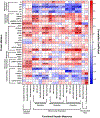Compromised hepatic mitochondrial fatty acid oxidation and reduced markers of mitochondrial turnover in human NAFLD
- PMID: 35000203
- PMCID: PMC9270503
- DOI: 10.1002/hep.32324
Compromised hepatic mitochondrial fatty acid oxidation and reduced markers of mitochondrial turnover in human NAFLD
Abstract
Background and aims: NAFLD and its more-advanced form, steatohepatitis (NASH), is associated with obesity and is an independent risk factor for cardiovascular, liver-related, and all-cause mortality. Available human data examining hepatic mitochondrial fatty acid oxidation (FAO) and hepatic mitochondrial turnover in NAFLD and NASH are scant.
Approach and results: To investigate this relationship, liver biopsies were obtained from patients with obesity undergoing bariatric surgery and data clustered into four groups based on hepatic histopathological classification: Control (CTRL; no disease); NAFL (steatosis only); Borderline-NASH (steatosis with lobular inflammation or hepatocellular ballooning); and Definite-NASH (D-NASH; steatosis, lobular inflammation, and hepatocellular ballooning). Hepatic mitochondrial complete FAO to CO2 and the rate-limiting enzyme in β-oxidation (β-hydroxyacyl-CoA dehydrogenase activity) were reduced by ~40%-50% with D-NASH compared with CTRL. This corresponded with increased hepatic mitochondrial reactive oxygen species production, as well as dramatic reductions in markers of mitochondrial biogenesis, autophagy, mitophagy, fission, and fusion in NAFL and NASH.
Conclusions: These findings suggest that compromised hepatic FAO and mitochondrial turnover are intimately linked to increasing NAFLD severity in patients with obesity.
© 2022 American Association for the Study of Liver Diseases.
Conflict of interest statement
DECLARATION OF INTERESTS
No conflicts of interest, financial or otherwise, are declared by the authors.
Figures







Comment in
-
Letter to the editor: Compromised hepatic mitochondrial fatty acid oxidation and reduced markers of mitochondrial turnover in human NAFLD.Hepatology. 2022 Nov;76(5):E104-E105. doi: 10.1002/hep.32551. Epub 2022 May 19. Hepatology. 2022. PMID: 35491446 No abstract available.
References
-
- Chalasani N, Younossi Z, Lavine JE, Charlton M, Cusi K, Rinella M, Harrison SA, et al. The diagnosis and management of nonalcoholic fatty liver disease: Practice guidance from the American Association for the Study of Liver Diseases. Hepatology 2018;67:328–357. - PubMed
-
- Stepanova M, Rafiq N, Makhlouf H, Agrawal R, Kaur I, Younoszai Z, McCullough A, et al. Predictors of all-cause mortality and liver-related mortality in patients with non-alcoholic fatty liver disease (NAFLD). Digestive Diseases and Sciences 2013;58:3017–3023. - PubMed
-
- Rector RS, Thyfault JP, Morris RT, Laye MJ, Borengasser SJ, Booth FW, Ibdah JA. Daily exercise increases hepatic fatty acid oxidation and prevents steatosis in Otsuka Long-Evans Tokushima Fatty rats. American Journal of Physiology - Gastrointestinal and Liver Physiology 2008;294:G619–626. - PubMed
Publication types
MeSH terms
Substances
Grants and funding
LinkOut - more resources
Full Text Sources
Medical

